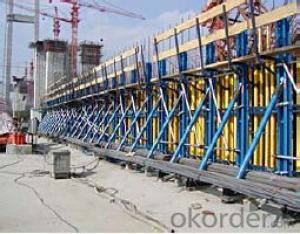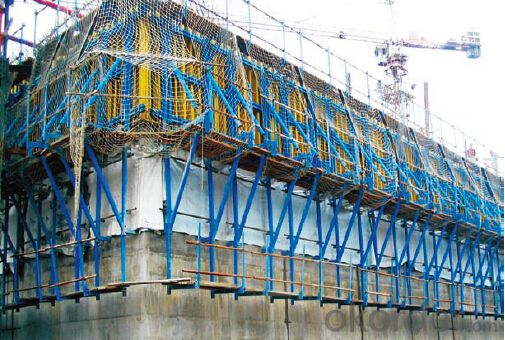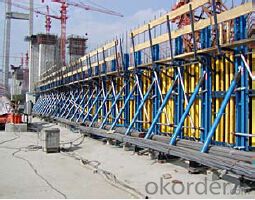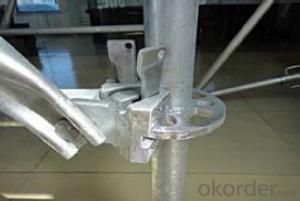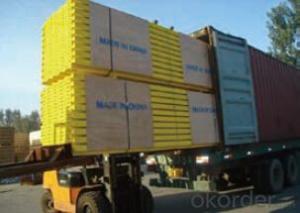Single Side Climbing Bracket for Formwork and Scaffolding System
- Loading Port:
- Tianjin
- Payment Terms:
- TT OR LC
- Min Order Qty:
- 50 m²
- Supply Capability:
- 1000 m²/month
OKorder Service Pledge
OKorder Financial Service
You Might Also Like
Single-side Climbing Bracket SCB180:
With CNBM SCB 180 climbing systems, the loads from the fresh concrete pressure are
transferred through the brackets by means of V-strongbacks and compression braces into the
scaffold anchors.
Typical applications for the SCB 180 are dams, locks, cooling towers, pier heads, tunnels, and
bank vaults.
The formwork is simply tilted backwards when striking takes place. The 1.80 m wide bracket
requires only a minimum of space.
Characteristics:
◆ Economical and safe anchoring
The M30/D20 climbing cones have been designed especially for single-sided concreting using
SCB180 in dam construction, and to allow the transfer of high tensile and shear forces into the still
fresh, unreinforced concrete. Without wall-through tie-rods, finished concrete is perfect.
◆ Stable and cost-effective for high loads
generous bracket spacings allow large-area formwork units with optimal utilization of the bearing
capacity. This leads to extremely economical solutions.
◆ Simple and flexible planning
With SCB180 single-sided climbing formwork, circular structures can also be concreted without
undergoing any large planning process. Even use on inclined walls is feasible without any special
measures because additional concrete loads or lifting forces can be safely transferred into the
structure.
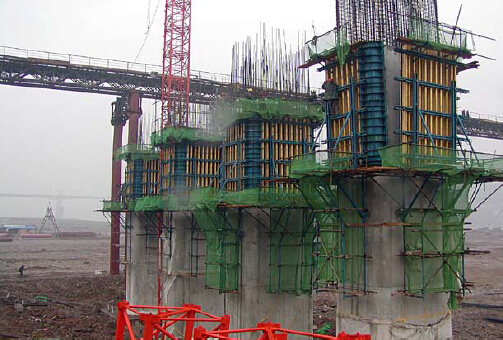
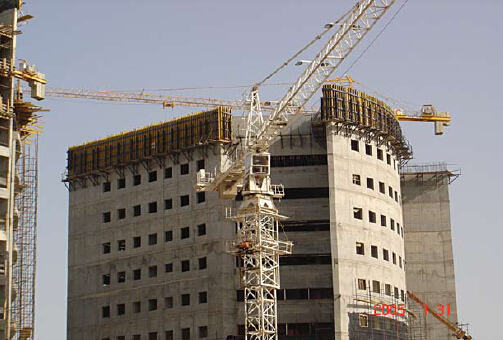
- Q: How does steel formwork prevent concrete mixture separation during pouring?
- Steel formwork is used in construction projects to provide a temporary structure that holds the concrete in place until it sets and hardens. One of the key benefits of using steel formwork is that it prevents the concrete mixture from separating during the pouring process. The steel formwork is carefully designed and constructed to create a tight enclosure for the concrete, ensuring that it remains in its desired shape and consistency. It is made up of steel panels and frames that are securely fastened together to create a rigid structure. When the concrete mixture is poured into the steel formwork, it is held in place by the walls of the formwork itself. The steel panels and frames provide a smooth and even surface for the concrete to be poured onto, preventing any separation or segregation of the mixture. Furthermore, the steel formwork is designed with properly aligned joints and connections, which further helps in preventing any leakage or seepage of the concrete mixture. This ensures that the concrete remains intact and does not separate into its constituent materials such as aggregates, cement, and water. Additionally, the steel formwork is capable of withstanding the pressure exerted by the weight of the concrete. This prevents any deformation or movement of the formwork during the pouring process, which could potentially cause the concrete to separate or shift. Overall, the use of steel formwork provides a strong and stable structure that prevents the concrete mixture from separating during pouring. It ensures that the concrete remains in its desired form and consistency, resulting in a high-quality and durable finished product.
- Q: What are the safety considerations when using steel formwork?
- There are several important safety considerations to bear in mind when utilizing steel formwork. To begin with, it is crucial to properly install and secure the steel formwork. This entails ensuring firm support and bracing to prevent any movement or collapse during construction. Regular inspections should also be carried out to detect any signs of damage or wear that could compromise the stability of the formwork. Another critical aspect is the implementation of adequate fall protection measures. This involves equipping workers with suitable safety harnesses and installing guardrails or barriers on elevated platforms or edges where falls may occur. It is imperative that workers receive proper training on the use of these safety devices and are fully aware of the potential hazards associated with working at heights. Moreover, the weight and load-bearing capacities of the steel formwork must be carefully considered. Given their substantial weight, it is essential to ensure that the supporting structures and equipment, such as cranes or hoists, are capable of safely lifting and moving the formwork without causing accidents or injuries. Furthermore, proper lifting and handling techniques should be adhered to when working with steel formwork. This necessitates using appropriate lifting equipment, such as slings or chains, and ensuring that the load is evenly distributed to prevent any imbalances or strain on workers or equipment. Lastly, effective communication and coordination among workers are paramount when employing steel formwork. This entails providing clear instructions and guidelines, ensuring workers are aware of potential hazards or risks, and establishing a system for reporting safety concerns or incidents. In summary, the safety considerations associated with steel formwork revolve around proper installation, fall protection, weight and load-bearing capacities, lifting and handling techniques, and effective communication and coordination. By addressing these considerations, construction workers can minimize risks and cultivate a safe working environment.
- Q: What are the considerations when designing steel formwork for culverts?
- When designing steel formwork for culverts, several considerations need to be taken into account. Firstly, the formwork must be strong and durable enough to withstand the pressures exerted by the concrete during the pouring and curing process. It should be able to support the weight of the concrete without warping or collapsing. Additionally, the formwork should be designed to allow for proper drainage and prevent the occurrence of any water accumulation or pockets within the culvert. Adequate provision for weep holes and outlets should be made to ensure smooth water flow. The geometry and dimensions of the culvert must be carefully considered when designing the formwork. It should be designed to accurately shape the culvert, ensuring that it conforms to the desired size and shape specifications. This may involve the use of adjustable panels or modular systems to accommodate different culvert sizes and configurations. Another important consideration is ease of assembly and disassembly. The formwork should be designed in a way that allows for quick and efficient installation and removal. This can help save time and labor costs during construction. Lastly, safety is a crucial consideration when designing steel formwork for culverts. Adequate precautions should be taken to ensure the stability of the formwork during construction, preventing any accidents or injuries. This may involve incorporating proper bracing, anchoring, and support systems to maintain the integrity of the formwork structure. Overall, the considerations when designing steel formwork for culverts include strength, drainage, geometry, ease of assembly, and safety. By addressing these factors, a well-designed formwork system can facilitate the construction of durable and functional culverts.
- Q: How does steel formwork compare to other formwork materials in terms of durability?
- Steel formwork is highly regarded for its exceptional durability when compared to other formwork materials. Steel is known for its strength and resilience, making it a reliable choice for construction projects that require long-lasting formwork. Unlike materials like wood or plastic, steel formwork is resistant to warping, cracking, and rotting, ensuring its longevity and effectiveness over time. Additionally, steel formwork is highly resistant to the elements, including harsh weather conditions and exposure to chemicals. It can withstand heavy loads and pressures, making it suitable for projects that involve high-rise buildings, bridges, or other structures that require robust support during the construction process. Furthermore, steel formwork offers the advantage of being reusable. After a concrete pour, steel formwork can be easily dismantled, cleaned, and reassembled for future use. This reusability factor not only reduces construction waste but also proves to be cost-effective in the long run. However, it is important to note that steel formwork requires regular maintenance to prevent corrosion. Proper cleaning, rust removal, and application of protective coatings are necessary to ensure the formwork's durability and extend its lifespan. In summary, steel formwork outperforms other formwork materials in terms of durability due to its strength, resistance to various elements, and reusability. While it requires maintenance to prevent corrosion, steel formwork remains a preferred choice for construction projects that demand long-lasting and reliable formwork solutions.
- Q: What are the common design considerations for steel formwork in seismic areas?
- When designing steel formwork for seismic areas, there are several common considerations that need to be taken into account to ensure the safety and stability of the structure. These considerations include: 1. Material strength: The steel used for formwork should have high tensile strength and ductility to withstand the seismic forces. High-strength steel, such as Grade 60 or Grade 80, is often used to ensure the formwork can resist the lateral forces generated during an earthquake. 2. Connection details: The connections between different steel formwork components need to be carefully designed to withstand seismic loads. Proper welding or bolting techniques should be employed to ensure the connections are strong enough to resist the dynamic forces. 3. Reinforcement: Additional reinforcement, such as steel bars or mesh, may be required in the formwork design to enhance its structural integrity. This reinforcement helps to distribute the seismic forces and prevent the formation of weak points or failure zones. 4. Stiffness and rigidity: The formwork system should be designed to be sufficiently stiff and rigid to minimize deformations and prevent excessive movement during an earthquake. This can be achieved by using thicker steel plates or adding diagonal bracing elements to increase the overall stiffness of the system. 5. Anchorage and support: The formwork needs to be securely anchored to the ground or the supporting structure to prevent it from shifting or collapsing during seismic events. Adequate anchorage and support systems, such as anchor bolts or braces, should be incorporated into the design to ensure the stability of the formwork. 6. Compatibility with other building components: The design of the steel formwork should consider its compatibility with other structural elements, such as concrete walls or columns. Proper coordination and integration with other building components are essential to ensure the overall stability and seismic performance of the structure. 7. Robustness and redundancy: The formwork design should have redundancy and robustness features to withstand unexpected loading conditions or localized damage during an earthquake. This can be achieved by incorporating multiple load paths or redundant structural elements into the formwork system. Overall, the common design considerations for steel formwork in seismic areas revolve around ensuring the strength, stability, and compatibility of the formwork system to withstand the dynamic forces generated by earthquakes. By addressing these considerations, engineers can develop robust and resilient formwork designs that contribute to the overall seismic safety of the structure.
- Q: Can steel formwork be used in areas with limited construction space or tight site constraints?
- Areas with limited construction space or tight site constraints can benefit from the use of steel formwork. This is because steel formwork is known for its versatility and adaptability, making it suitable for various construction projects, even those with limited space. One of the main advantages of steel formwork in these situations is its strength and durability. It can withstand high pressure and heavy loads, allowing it to be used in confined areas without compromising its structural integrity. This makes it an ideal choice for areas with limited construction space or tight site constraints. Additionally, steel formwork is highly flexible and can be easily adjusted or modified to fit the available space. It can be customized to different shapes and sizes, making it suitable for complex or irregularly shaped areas. This adaptability makes steel formwork a practical solution for construction projects with limited space. Moreover, steel formwork is reusable and can be dismantled and reassembled in different locations. This is particularly advantageous in areas with tight site constraints, as it allows the formwork to be easily moved and reused in different parts of the construction site. This not only saves time and effort but also reduces the need for additional formwork materials. Overall, steel formwork is a suitable choice for areas with limited construction space or tight site constraints. Its strength, adaptability, and reusability make it a practical solution for various construction projects, ensuring efficient and effective use of the available space.
- Q: How does steel formwork affect the overall energy efficiency of the structure?
- Steel formwork can positively impact the overall energy efficiency of a structure in several ways. Firstly, steel formwork provides a durable and robust framework, ensuring precise construction and reducing the need for additional materials. This results in a more tightly sealed structure, minimizing air infiltration and heat loss. Additionally, steel formwork allows for the efficient installation of insulation materials, improving thermal performance and reducing energy consumption for heating and cooling. Moreover, the reusable nature of steel formwork reduces waste and promotes sustainability, which further enhances the overall energy efficiency of the structure.
- Q: What are the different steel grades used in steel formwork?
- There are several different steel grades that are commonly used in steel formwork, each with their own specific characteristics and advantages. Some of the most common steel grades used in steel formwork include: 1. Mild Steel (Grade 250): Mild steel is a low carbon steel that is relatively inexpensive and easy to work with. It offers good strength and durability, making it suitable for many construction applications. However, it may not have the same level of resistance to corrosion as other steel grades. 2. High Tensile Steel (Grade 500): High tensile steel is a type of steel that has a higher strength-to-weight ratio compared to mild steel. It offers superior strength and durability, making it suitable for heavy-duty applications. High tensile steel is often used in formwork for structures that require greater load-bearing capacity. 3. Stainless Steel: Stainless steel is a corrosion-resistant alloy that contains a minimum of 10.5% chromium. It offers excellent resistance to corrosion, making it ideal for formwork that will be exposed to harsh environmental conditions or chemicals. Stainless steel also has a high strength-to-weight ratio and is often used in marine and chemical industry applications. 4. Weathering Steel (Grade 350): Weathering steel, also known as corten steel, is a high-strength, low-alloy steel that forms a protective layer of rust when exposed to the elements. This protective layer helps to prevent further corrosion, making it suitable for formwork in outdoor environments. Weathering steel is often used in bridge construction and other infrastructure projects. 5. Galvanized Steel: Galvanized steel is steel that has been coated with zinc to provide protection against corrosion. The zinc coating acts as a barrier, preventing moisture and oxygen from reaching the underlying steel. Galvanized steel formwork is commonly used in concrete construction, as it offers excellent corrosion resistance and durability. Overall, the choice of steel grade for steel formwork will depend on various factors including the specific application, load-bearing requirements, and environmental conditions. It is important to select the appropriate steel grade to ensure the longevity and performance of the formwork system.
- Q: How does steel formwork handle different types of concrete mixes?
- Steel formwork is a versatile and durable option for handling different types of concrete mixes. It is designed to withstand the pressure and weight of various concrete mixes, making it suitable for both regular and specialized applications. Steel formwork has a high load-bearing capacity, allowing it to handle heavy concrete mixes without deforming or collapsing. This is particularly important for concrete mixes with a high water-cement ratio or those containing additives such as admixtures, which can increase the fluidity and weight of the concrete. Moreover, steel formwork is resistant to chemical reactions that can occur between certain concrete mixes and other materials. It can withstand the alkaline nature of concrete, preventing corrosion or degradation over time. This makes it suitable for handling concrete mixes that may have aggressive chemical compositions or contain aggressive substances, such as sulfates or chlorides. Steel formwork also offers flexibility in terms of shape and size. It can be easily customized to accommodate different concrete designs and structures, allowing for the creation of complex shapes and architectural features. This versatility makes steel formwork suitable for handling concrete mixes used in modern construction, where unique and intricate designs are often desired. In addition, steel formwork provides a smooth and consistent finish to the concrete surface. This is particularly beneficial for concrete mixes that require a high-quality finish, such as those used in architectural applications or exposed concrete structures. The smoothness of the steel formwork surface helps in achieving a visually appealing and structurally sound concrete finish. Overall, steel formwork is an ideal choice for handling different types of concrete mixes due to its strength, resistance to chemical reactions, flexibility, and ability to provide a smooth finish. It ensures the integrity and quality of the concrete structure, making it a reliable and efficient solution for construction projects of all sizes and complexities.
- Q: Can steel formwork be used in bridge construction?
- Yes, steel formwork can be used in bridge construction. Steel formwork refers to the use of steel panels or frames to create the desired shape and structure of a bridge during the construction process. Steel formwork is often preferred in bridge construction due to its durability, strength, and ability to withstand the high loads and stresses that bridges are subjected to. It is capable of withstanding heavy concrete pouring and can be reused multiple times, making it a cost-effective choice for bridge construction. Additionally, steel formwork offers flexibility in design and allows for intricate and complex shapes to be constructed, ensuring the bridge meets the desired specifications and requirements. Overall, steel formwork is a popular choice in bridge construction due to its strength, durability, reusability, and versatility.
Send your message to us
Single Side Climbing Bracket for Formwork and Scaffolding System
- Loading Port:
- Tianjin
- Payment Terms:
- TT OR LC
- Min Order Qty:
- 50 m²
- Supply Capability:
- 1000 m²/month
OKorder Service Pledge
OKorder Financial Service
Similar products
Hot products
Hot Searches

